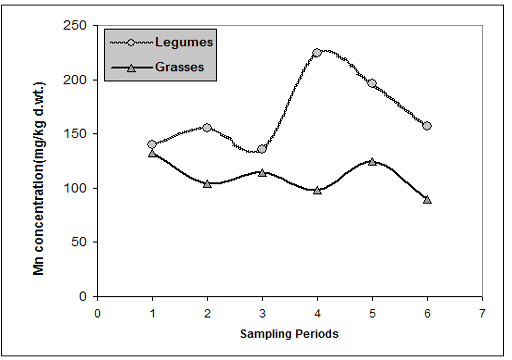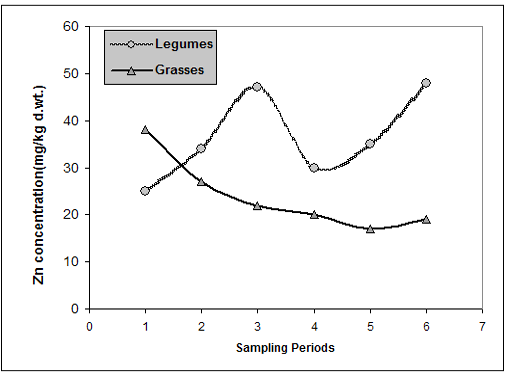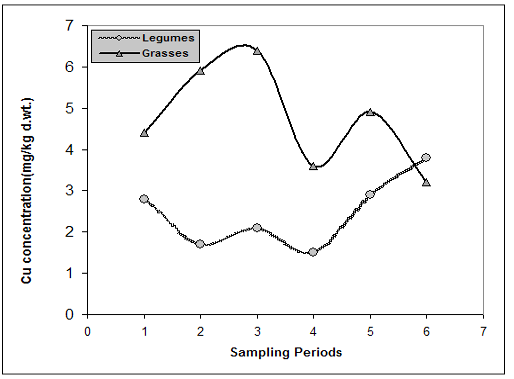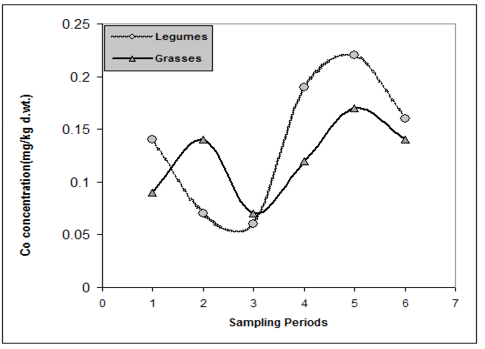Advances in Animal and Veterinary Sciences
Research Article
Evaluation of Deficiency and Toxicity of Wild Forage Micro-Minerals as Potential Hazards for Grazing Livestock under Semi-Arid Environmental Conditions
Zafar Iqbal Khan1*, Muhammad Ibrahim2, Kafeel Ahmad1, Muhammad Sher3, Hazoor Ahmad3, Abrar Hussain4, Fahim Arshad5, Vincenzo Tufarelli6, Shafaqat Ali7, Eugenio Cazzato8
1Department of Biological Sciences: 7Department of Chemistry, University of Sargodha, Sargodha, Pakistan; 2Department of Agricultural Environment, National Academy of Agricultural Science, Rural Development Administration, Suwon, Korea; 3Department of Environmental Sciences & Engineering, Government College University Faisalabad, Pakistan; 4Science and Technology Division, University of Education, Township Campus, Lahore, Pakistan; 5Department of Botany, University of Education, Okara Campus, Okara, Pakistan; 6Department DETO, Section of Veterinary Science and Animal Production, University of Bari ‘Aldo Moro’, Valenzano, Italy; 8Department of Agro-Environmental and Territorial Sciences, University of Bari ‘Aldo Moro’, Bari, Italy.
Abstract | Micro-minerals (iron, manganese, zinc, copper, and cobalt) content of some wild legumes and grasses from arid environment of central Punjab (Pakistan) was evaluated during the rainy and dry seasons. The micro-mineral contents of legumes were significantly higher in dry season than rainy season except iron. Legume contents of all minerals except iron were higher during dry season compared to those found during the rainy season under the same environment. Grass forages contained higher values of manganese, zinc, and copper during rainy season and the reverse was true for grasses iron and cobalt during the dry season. Results indicated that legumes were the best sources of manganese and zinc than grasses during both seasons, and grasses had higher amounts of copper and cobalt than legumes while both legumes and grasses were at par with respect to iron. All mean mineral forage values except iron at both seasons were below the critical levels required for ruminants for their growth and reproductive aspects, thus mineral supplements are warranted to alleviate the problems of deficiency in livestock grazing there in legume and grass pastures.
Keywords | Seasonality, Toxicity, Micro-minerals, Forage
Editor | Kuldeep Dhama, Indian Veterinary Research Institute, Uttar Pradesh, India.
Received | June 02, 2015; Revised | June 17, 2015; Accepted | June 18, 2015; Published | June 22, 2015
*Correspondence | Zafar Iqbal Khan, University of Sargodha, Sargodha, Pakistan; Email: zikhan11@gmail.com
Citation | Khan ZI, Ibrahim M, Ahmad K, Sher M, Ahmad H, Hussain A, Arshad F, Tufarelli V, Ali S, Cazzato E (2015). Evaluation of deficiency and toxicity of wild forage micro-minerals as potential hazards for grazing livestock under semi-arid environmental conditions. Adv. Anim. Vet. Sci. 3(8): 418-421.
DOI | http://dx.doi.org/10.14737/journal.aavs/2015/3.8.418.421
ISSN (Online) | 2307-8316; ISSN (Print) | 2309-3331
Copyright © 2015 Khan et al. This is an open access article distributed under the Creative Commons Attribution License, which permits unrestricted use, distribution, and reproduction in any medium, provided the original work is properly cited.
Introduction
Most of the Pakistani lands fall under arid and semi-arid type and very little attention has been paid towards evaluation of the minerals content in soil and forages of these areas. Forage and soil mineral imbalances are common in these arid and semi-arid areas typified by acidic and infertile soils (Ashraf et al., 2006; Khan et al., 2009). In many areas of the Punjab in Pakistan, deficiencies of both macro- and micro-minerals are common (Khan et al., 2008) and comprehensive mineral supplementation is recommended for successful livestock production.
The information on the mineral status of soil and pasture could be of great importance to livestock producers and environmentalists. Moreover, pasture amendment with fertilizers can create an environment more suitable for plant growth and improve forage nutritive value in this eco-zones deficient in most minerals essential for enhancing the livestock production and reproduction potential (Tiffany et al., 2001).
Therefore, the aim of the present investigation is to provide information to small livestock holders raising ruminants as well as to increase and improve the capability of Livestock Station owned by the Government of Punjab (Pakistan) regarding the use of minerals and overcome the nutritional constraints limiting productivity and impairing the health of farm animals.
Material and Methods
Investigations were conducted at Livestock Station Khizerabad, Sargodha, with arid and semi-arid climate located in north western Punjab at an altitude of 187 m. Average temperature during the experimental trial was 45 ± 5oC during summer and 20 ± 3oC during winter. Relative humidity was 35 ± 5% during summer and 85 ± 5% during winter. To study the transfer of mineral nutrients from soil to forage, dominant forage species consisting of both legumes and grasses and mostly grazed by ruminants were collected during rainy and dry season of the year. The plants samples were collected at advanced maturity in the months of June to September during rainy season and during dry season.
The collected forage species form important feed sources for grazing livestock were selected based on local herdsmen’s knowledge in the study area and after careful observation of the grazing behaviour of ruminants. A total of thirty composite forage samples were collected after one month interval during each season from the pastures of the animal experimental farm for evaluation of micro mineral contents.
All wild forage samples were collected from the same sites from where soil samples were obtained. These samples then were washed with 1% HCl followed by four washings with distilled water to remove dust particles. Forages samples then were oven –dried at 70oC for 120 h, ground to powder, and stored in clean dry brown paper bags for further analysis. The dried ground plant material nearly 1 g was digested in sulphuric acid and hydrogen peroxide according to the methods outlined by Wolf (1982) and Ding et al. (2006).
Table 1: Trace mineral contents in wild-type legumes and grasses as affected by seasonal variation
|
Plant type |
Season |
Minerals (mg kg–1) |
||||
|
Fe |
Mn |
Zn |
Cu |
Co |
||
|
Legumes |
Rainy |
534 |
144 |
36 |
2.2 |
0.05 |
|
Dry |
485 |
192 |
38 |
2.8 |
0.20 |
|
|
SEM |
52.1 |
29.3 |
2.2 |
0.21 |
0.03 |
|
|
P-value |
** |
** |
* |
* |
** |
|
|
Grasses |
Rainy |
506 |
117 |
29 |
5.6 |
0.10 |
|
Dry |
523 |
105 |
19 |
3.9 |
0.14 |
|
|
SEM |
57.9 |
21.7 |
1.5 |
0.44 |
0.02 |
|
|
P-value |
* |
* |
** |
** |
* |
|
* P < 0.05; ** P < 0.01
Statistical Analysis
The average concentrations of micro-minerals in forage samples were evaluated using the ANOVA option of the general linear model of the Statistical Program for Social Sciences (SPSS). Following Steel and Torrie (1980), the significant differences between mean data were determined at 0.05, 0.01, and 0.001 levels.
Results and Discussion
Forage micro mineral analyses as related to months are presented in Figures 1, 2, 3, 4 and 5, and the mean concentration of each forage micro-mineral in Table 1, respectively. In both legume and grass forage species zinc, manganese, copper and cobalt content were higher in dry season than those in rainy season except copper in dry pasture and iron in legumes which were found to be higher in dry season. The legumes had higher Fe, Zn and Co content than the grasses in the rainy season and vice versa in dry season. Similarly in the dry season the grasses had higher content of all trace minerals except Cu content than those of legumes during the dry season.

Figure 2: Levels of Mn in legume and grass forages

Figure 3: Levels of Zn in legume and grass forages

Figure 4: Levels of Cu in legume and grass forages

Figure 5: Levels of Co in legume and grass forages
The level of all minerals in the both pastures was affected significantly by the seasonal as well as pasture. It has been reported that rapid growth in rainy season tended to dilute some minerals in the forage plants. Low values of some minerals as found in forages in the present investigation have already been reported by some researches (Fujihara et al., 1994; Khan et al., 2009). Iron concentration was 534 mg/kg in rainy season and 485 mg/kg in the dry season in legumes and 506 mg/kg in rainy season and 523 mg/kg during dry season in grasses which are considered far above the recommended level for ruminants (NRC, 1996). Similarly, Mn concentrations in legumes were 144 and 192 mg/kg and in grasses 117 and 105 mg/kg during rainy and dry season, respectively. These values are sufficient for the requirement of livestock in excess but below the tolerance level indicating no danger of toxicity in ruminants (McDowell and Arthington, 2005). The zinc contents in legumes were 36 and 38 mg/kg and in grasses 29 and 19 mg/kg during rainy and dry season, respectively and were considered at low limit of adequacy except during the dry season in legumes where it was at marginal deficient level as suggested by NRC (1996) and McDowell and Arthington (2005).
Cu concentrations of legumes were 2.2 and 2.80 mg/kg and of grasses 5.6 and 3.9 mg/kg during rainy and dry season, respectively which were largely insufficient to maintain the normal plasma level as established by NRC (1996) and McDowell (1985) pointing to the supplementation of livestock with a tailored mixture having the most available form of Cu. The Cu levels in legumes during rainy season was 0.05 and in dry season 0.02 mg/kg and in grasses 0.11 and 0.14 mg/kg during rainy and dry season, respectively and these values were in the low limit of adequacy indicated by NRC (1996) and McDowell and Arthington (2005) for ruminants grazing at pasture.
The low levels of Co in forages during both seasons suggest the mineral supplementation as these values are considered to be limiting factors in these pastures. The quality of pasture grass, however, would be markedly affected with changes in their growth stages and better time to use these pastures (Masters et al., 1993). The concentrations of various trace elements fluctuated inconsistently at different sampling periods, but in most instances the concentrations of Cu, Co and Zn except at some sampling times in legumes and at one sampling period in grass pastures, these elements were far below the recommended requirements for grazing ruminants. Similarly, low concentrations of trace elements have already been reported by Khan et al. (2008, 2009) and Masters et al. (1993) in forages collected from different pastures. Fe and Mn levels were in excess, while other elements were in those concentrations what can be expected from acidic soil were found. There were major differences in the trace element concentrations in relation to pasture and season on the farm. Like macro minerals, these differences can likely be related to rainfall, soil type, and pasture species (Masters et al., 1993).
In conclusion, based on the results of the present investigation, livestock at this farm requires additional salts throughout the year, therefore, provision of micro minerals, mixed with salt would provide a convenient, inexpensive and effective means of ensuring adequate intakes of micro-elements.
ACKNOWLEDGEMENTS
The authors would like to thank their Departments for support of this study.
CONFLICT OF INTEREST
The authors of this article declare that they do not have any conflicting interests.
AUTHOR’S CONTRIBUTION
All the authors contributed equally to this research.
References





